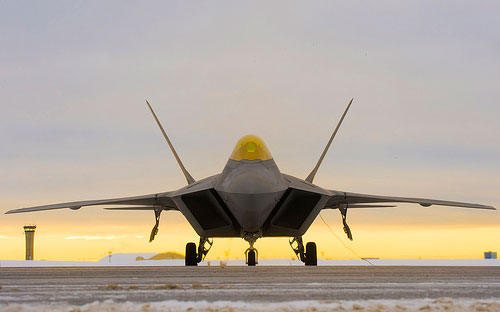On Monday, Secretary of Defense Robert Gates finally announced his long-planned cuts to big-ticket programs, including the F-22 Raptor and the VH-71 Presidential Helicopter. (Mother Jones previewed the cuts—and military spending opponents’ reactions—last month.) In Gates’ proposed budget, the F-22, VH-71, the Navy’s DDG-1000 Destroyer, Airborne Laser Missile Defense (a laser mounted on a Boeing 747), and the Army’s Future Combat Systems program are all targeted for modification or elimination.
In March, President Barack Obama said he recognized “the real choice between investments that are designed to keep the American people safe and those that are designed to make a defense contractor rich.” The proposals Gates revealed today are supposed to reflect that tradeoff. It’s no surprise, then, that defense contractors are rebelling against the proposed changes. The Washington Independent‘s Spencer Ackerman details the gathering storm:
In January, Lockheed Martin unveiled a website called Preserve Raptor Jobs, arguing that the F-22 fighter jet it produces for the Air Force was a jobs engine during trying economic times. A spokesman for Lockheed told TWI last month that the site was merely intended to “provide information” primarily to the jet’s “supplier base,” but lawmakers from F-22-producing states warned Gates against cutting funding for the jet — which costs approximately $143 million per plane, of which there are currently 183 — using talking points that sounded much like text on the site. Similarly, defenders of the Army’s Future Combat Systems program for tech-enabled land warfare — the target of a Government Accountability Office report this week that criticized its “staggering” cost-overruns of $300 million — have argued in recent days that the program is crucial to soldier safety against insurgent attacks, even though it has yet to be deployed in full. The Politico reported this week that Boeing has deployed 100 lobbyists to Washington to push back against potential cuts.
Lobbyists for defense contractors don’t get paid to sit on their hands, so you can bet that there’s a whole gaggle of them on Capitol Hill right now telling members of Congress and their aides how important x piece of Cold War-era weaponry is to national security and, naturally, jobs in members’ districts. That’s the kind of hard work that got the V-22 Osprey (now operational) revived four separate times by Congress after Dick Cheney—Dick Cheney!—tried unsuccessfully to kill it. You can bet that Lockheed Martin will try to ensure the F-22 enjoys a similar resurrection. Rep. Ike Skelton (D-Mo.), for one, doesn’t seem to be over the moon about Gates’ proposals. Skelton, the chair of the House armed services committee, released a statement this afternoon calling the proposal “a good faith effort” but emphasizing that “the buck stops with Congress,” which will “decide whether to support these proposals.”
Military spending critics are worried that Gates’ reforms—which many
see as modest—will prove hard to push through Congress. Winslow
Wheeler, a longtime Pentagon gadfly at the Center for Defense
Information, said in a statement released Monday afternoon that he
fears that the defense secretary’s “decisions on hardware will
completely preoccupy Congress.” Wheeler warns of a “major food fight”
over ending production of the F-22 and cutting other big procurement
projects. Some cuts Gates failed to make will undoubtedly draw further
criticism. Gordon Adams, former Clinton White House official for
national security budgeting and current national security professor at
American University, said in a statement that the Pentagon’s “failing
to make major reductions in other ballistic missile defense programs,
whose contribution to U.S. security has been minimal,” was
disappointing. I’ve asked the office of Rep. Barney Frank (D-Mass.), a
longtime critic of wasteful military spending and especially of missile
defense programs, to comment on Gates’ proposals. I’ll post what I hear
when I hear it.











